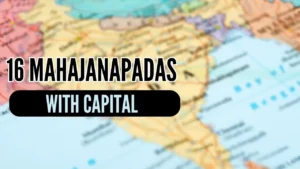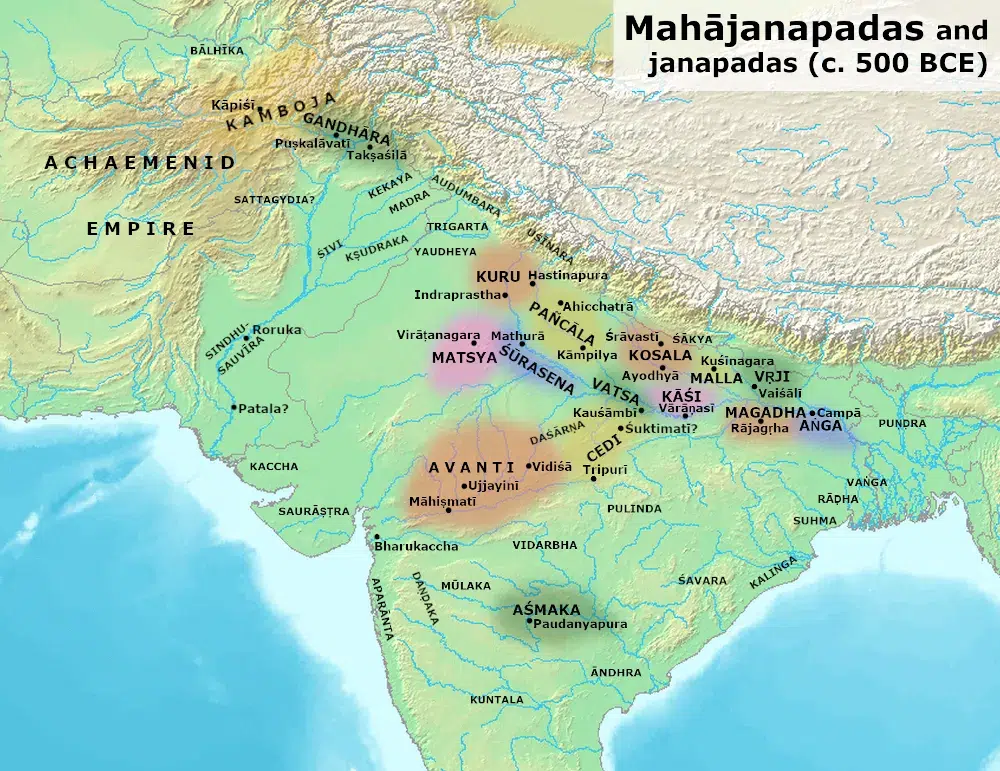Mahajanapadas holds a significant place in Indian history. These were political and military units or states that existed in the Indian subcontinent during ancient times, from the 6th century BCE to the 4th century BCE. The term “Mahajanapada” translates to “great country” or “great realm” in Sanskrit.

During this period, the Indian subcontinent was divided into several small and large kingdoms or republics. These Mahajanapada differed from each other in terms of their unique political and administrative systems, economic activities, and cultural practices.
Table of Contents
16 Mahajanapadas with Capital
The ancient Indian texts and early Greek accounts mention 16 prominent Mahajanapada. Here is a list:
| Sl No. | Mahajanapada | Capital |
|---|---|---|
| 1 | Anga | Champa |
| 2 | Magadha | Rajagriha (later shifted to Pataliputra) |
| 3 | Vajji | Vaishali |
| 4 | Malla | Kusinara |
| 5 | Chedi | Suktimati |
| 6 | Vatsa (or Vamsa) | Kausambi |
| 7 | Kuru | Indraprastha (later shifted to Hastinapura) |
| 8 | Panchala | Kampilya |
| 9 | Kashi (or Varanasi) | Varanasi |
| 10 | Kosala | Ayodhya |
| 11 | Avanti | Ujjain |
| 12 | Gandhara | Taxila |
| 13 | Kamboja | Rajapura |
| 14 | Matsya | Viratanagari |
| 15 | Surasena | Mathura |
| 16 | Assaka | Potana or Potali |
Magadha: The Powerful Kingdom
Each Mahajanapada had its own capital and ruling dynasty. Some of these, such as Magadha, grew in power and played a significant role in ancient Indian history. The rise of the Magadha kingdom, in particular, led to the emergence of the Maurya Empire under Chandragupta Maurya and the Gupta Empire.
Read Also: Vedic Period: The Great Age of 4 Vedas in Indian History
Impact on Indian History
The period of Mahajanapada marked a crucial transition in Indian history, with the development of urban centers, the rise of territorial states, and the spread of religious and philosophical ideas. This era laid the foundation for the subsequent kingdoms and empires in the Indian subcontinent.
Read Also: Constitution of India: Objectives & 11 Salient Features
16 Mahajanapadas Map

Read Also: Panchayati Raj system in India with 3 Tier Structure
Frequently Asked Questions
What is Mahajanapadas?
Mahajanapada is an ancient term in Indian history that translates to “great country” or “great realm.” The term is derived from the Sanskrit language.
Why did the Rajas of Mahajanapadas build forts?
The construction of forts by the Rajas of Mahajanapada was primarily driven by the need for defense, protection, administration, control, and economic prosperity. They were essential structures that ensured the safety of the kingdom, facilitated governance, and projected the power and prestige of the ruling dynasty.
How many Mahajanapadas were there?
There were 16 prominent Mahajanapada mentioned in ancient Indian texts and early Greek accounts. These are: Anga, Magadha, Vajji (also known as Vriji or Vajjian Republic), Malla, Chedi, Vatsa (or Vamsa), Kuru, Panchala, Kashi (or Varanasi), Kosala, Avanti, Gandhara, Kamboja, Matsya, Surasena, Assaka